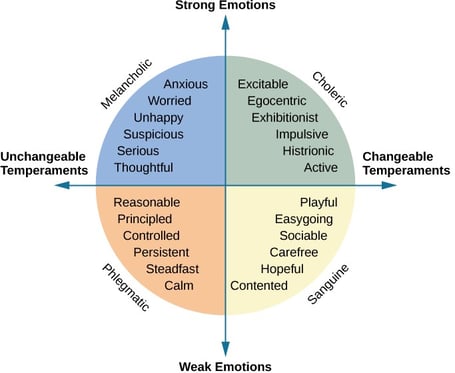Looking for a way to make your restaurant stand out from the competition? A white labeled food...
Why It's Important To Know The Different Temperaments of Employees
Imagine you are the owner of a business. You have worked hard to make it successful, and you have a great team of employees who contribute to its success. But what happens when one of your employees begins to exhibit signs of temperament problems? How do you deal with it, and more importantly, how does it affect the rest of your team?
After all, each employee will have their own way of approaching tasks and working with others. If you understand how each temperament works, you can better manage and utilize their strengths. In this article post, we'll explore the four main temperaments and discuss how you can use that knowledge to help your business grow. We will also discuss why not understanding these temperaments can lead to conflict in the workplace.
What are the four major temperament types?
We all have different temperaments and this can be extremely helpful to businesses if they know how to use it to their advantage. There are four main temperaments, which are: choleric, melancholic, phlegmatic, and sanguine.
Each temperament has its own strengths and weaknesses. For example, choleric people are often very ambitious and driven, but they can also be impatient and quick to anger.
Melancholic people are usually very creative and thoughtful, but they can also be more prone to sadness.
Phlegmatic people are often very calm and easy-going, but they can also be lazy and uninterested in new things.
Sanguine people are usually very outgoing and optimistic, but they can also be impulsive and irresponsible.
Each of us has a unique mix of these four personality types. However, one type is usually predominant.
Our goal should be to reach the middle Axis

If a business understands the different temperaments of its employees, it can use that knowledge to create a more productive and harmonious work environment. For example, if a business is trying to come up with new ideas, they may want to put together a team that includes both choleric and melancholic people.
If a business is trying to implement new systems or procedures, it may want to put together a team that includes both phlegmatic and sanguine people. By understanding the strengths and weaknesses of each temperament, businesses can create teams that are better equipped to achieve their goals.

How to identify an employee's temperament
Identifying an employee's temperament can be tricky because it requires a general understanding of the different temperaments.
Once you have a general understanding of the different temperaments, you can start to look for clues in an individual's behavior. Do they tend to be more withdrawn or outgoing? Are they more prone to outbursts of emotion or more level-headed? Generally speaking, the more you know about someone's personality, the easier it will be to identify their temperament. For example, if you know that someone is generally quite shy, they are likely to be phlegmatic.
If you are having trouble identifying an employee's temperament, you can always ask them directly. Many people are aware of their own temperaments and will be happy to share this information with you. However, some people may not be comfortable sharing this information, so it is important to respect their privacy.

How different temperaments can be beneficial in the workplace
Once you have identified an employee's temperament, you can start to think about how best to utilize their strengths. For example, if you have a choleric employee, you may want to give them tasks that require a lot of energy and ambition. If you have a melancholic employee, you may want to give them tasks that require a lot of creativity and thoughtfulness. If you have a phlegmatic employee, you may want to give them tasks that require a lot of calmness and patience. If you have a sanguine employee, you may want to give them tasks that require a lot of optimism and enthusiasm.

What are some signs that an employee's temperament is causing issues in the workplace?
A bad temper can be a major liability in the workplace. Employees who lose their cool frequently are more likely to make mistakes, alienate co-workers, and damage equipment. They are also a potential liability for employers, who could be held responsible for their employees' bad behavior.
There are several warning signs that an employee's temperament is causing problems in the workplace. First, they may have a history of conflict with co-workers or managers. Second, they may be quick to anger or snap over small issues. Third, they may have difficulty controlling their emotions, leading to outbursts or arguments. Finally, they may take their frustrations out on equipment or property, resulting in damage.
Here are signs that an employee's temperament is causing issues:
1. They are constantly getting into arguments with co-workers or customers.
2. They have difficulty completing tasks or meeting deadlines.
3. They seem to be in a bad mood all the time.
4. They take every opportunity to criticize their co-workers or the company.
If an employee is exhibiting any of these behaviors, it may be indicative of a larger problem with their temperament. In such cases, it may be necessary to have a discussion with the employee in order to help them improve their attitude and better cope with the challenges of the job.

How to adapt work environment based on an employees temperament type
One of the most important things a manager can do is to create a work environment that suits the temperament type of their employees. Not everyone thrives in a fast-paced, high-pressure environment, and forcing introverts or sensitive types into such an environment can lead to dissatisfaction and even burnout.
Conversely, an environment that is too relaxed and low-key can leave some employees feeling bored and unproductive. By taking the time to understand the individual temperaments of their team members, managers can make small changes that can have a big impact on employee satisfaction and productivity.
For example, an extroverted employee who enjoys working in a busy, social environment may do best in an open-plan office with plenty of opportunities for collaboration. On the other hand, an introverted employee who prefers quieter surroundings may prefer to work in a private office or cubicle. Likewise, a highly sensitive employee may appreciate having control over their work environment, such as the ability to adjust the lighting or temperature. By making simple adjustments to the work environment, managers can create a space that is conducive to each individual's unique needs and preferences.

What are some tips for working with someone who has a different temperament than you?
At some point, will we all have to work with someone who has a different temperament than us. While this can be challenging, it can also be a great opportunity to learn about other people and to gain a new perspective. Here are some tips for working with someone who has a different temperament than you:
1. Try to understand where they are coming from. Instead of getting defensive, try to see things from their perspective. This can be difficult, but it is important to remember that everyone is coming from a different place.
2. Be honest about your own emotions. If you are feeling frustrated, angry, or overwhelmed, it is important to communicate this to the other person. Trying to bottle up your emotions will only make the situation worse.
3. Seek out common ground. Even if you have different temperaments, there are likely areas that you agree on. Focusing on these areas can help you to build a better relationship with the other person.
4. Be respectful of their boundaries. Just as you have a right to your own space, so does the other person. Respect their need for personal space and give them the same courtesy that you would want in return.
5. Take breaks as needed. If the situation is becoming too stressful, take a step back and take some time for yourself. This can help you to regroup and approach the situation with fresh energy.

Tips for managing difficult personalities in the workplace
It's no secret that some people are just naturally difficult to get along with. Whether it's because they're always in a bad mood or they're just constantly causing drama, managing these types of personalities can be a challenge. However, there are some things you can do to make the situation more manageable.
The first step is to try to understand the difficult personality. What might be causing them to act out or be disruptive? Once you have a better understanding of the situation, you can start to look for ways to defuse the tension. This might involve having a conversation with the person, or it might mean delegating tasks in a way that doesn't put them in direct competition with others. It's also important to set clear boundaries and expectations. Let the person know what is acceptable behavior and what is not.
Moreover, try to avoid getting drawn into any negative arguments or drama. and try to be as professional and cordial as possible, even if the other person is not behaving in the same way. Lastly, if all else fails, you may need to speak with your manager or HR department to see if there are any options for dealing with the situation.
Also, it's important, not to take things personally. Difficult personalities can be frustrating, but remember that it's not about you.
By following these tips, you should be able to successfully manage even the most difficult personalities in the workplace.
 How can you create a positive work environment for all employees, regardless of their temperament?
How can you create a positive work environment for all employees, regardless of their temperament?
One of the keys to creating a positive work environment is to acknowledge and appreciate the fact that each employee has their own unique temperament. Some people are naturally outgoing and enjoy working in a busy and lively atmosphere. Others prefer a calmer environment where they can focus on their work without distractions.
There are a number of ways to create such an environment, regardless of the temperaments of the employees. First, it is important to communicate clearly and openly with all employees.
This includes letting them know what is expected of them and providing feedback on their performance. Second, it is important to foster a spirit of collaboration by encouraging employees to work together towards common goals.
Finally, it is important to create opportunities for employee development and growth. By taking these steps, you can create a positive work environment for all employees, regardless of their temperament.

Conclusion
Remember that each employee is unique and has their own individual temperament. Rather than try to force everyone into the same mold, it's better to create a work environment that recognizes and celebrates these differences. By doing so, you will create a positive and productive workplace for all.
Now that you understand, the different temperaments, and the importance of managing difficult personalities, let's take a look at the following reminders to help keep things in perspective.
1. Avoid taking things personally. Difficult personalities can be frustrating, but remember that it's not about you.
2. Communicate clearly and openly with all employees. This includes letting them know what is expected of them and providing feedback on their performance.
3. Try to understand the difficult personality. What might be causing them to act out or be disruptive? Once you have a better understanding of the situation, you can start to look for ways to defuse the tension.
4. Set clear boundaries and expectations. Let the person know what is acceptable behavior and what is not.
5. Avoid getting drawn into any negative arguments or drama. Be as professional and cordial as possible, even if the other person is not behaving in the same way.
6. If all else fails, you may need to speak with your manager or HR department to see if there are any options for dealing with the situation.
By following these tips, you should be able to successfully manage even the most difficult personalities in the workplace and help create a positive work environment for all employees which can unlock the keys to a productive and successful business. .

-3.png?height=200&name=Untitled%20design%20(3)-3.png)

